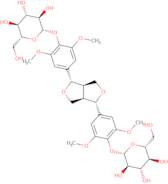Informations sur le produit
- β-D-Glucopyranoside, (tetrahydro-1H,3H-furo[3,4-c]furan-1,4-diyl)bis(2,6-dimethoxy-4,1-phenylene) bis-, [1S-(1α,3aα,4α,6aα)]-
- 1H,3H-Furo[3,4-c]furan, β-D-glucopyranoside deriv.
- [(1S,3aR,4S,6aR)-Tetrahydro-1H,3H-furo[3,4-c]furan-1,4-diyl]bis(2,6-dimethoxy-4,1-phenylene) bis-β-D-glucopyranoside
- β-D-Glucopyranoside, [(1S,3aR,4S,6aR)-tetrahydro-1H,3H-furo[3,4-c]furan-1,4-diyl]bis(2,6-dimethoxy-4,1-phenylene) bis-
Liriodendrin is a natural compound that is isolated from the roots of pueraria lobata. It is a sodium salt that has been shown to have anti-inflammatory effects in vitro and in vivo. Liriodendrin has been found to inhibit the production of inflammatory mediators such as prostaglandins, leukotrienes, and histamine. In addition, it inhibits the activity of enzymes such as cyclooxygenase and lipoxygenase. Liriodendrin also inhibits tumor necrosis factor-α (TNF-α) and interleukin-1β (IL-1β), which are pro-inflammatory cytokines implicated in the pathology of psoriasis.
Pueraria lobata contains several compounds including 3-O-caffeoylquinic acid and sargentodoxa, which could be responsible for its anti-inflammatory properties. This plant extract has been found to be effective against skin cells when tested





